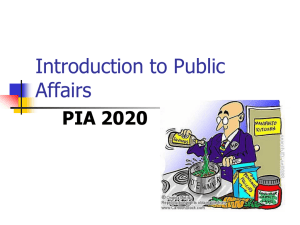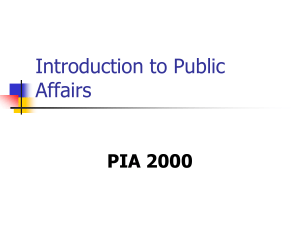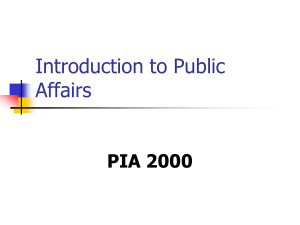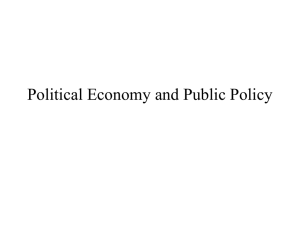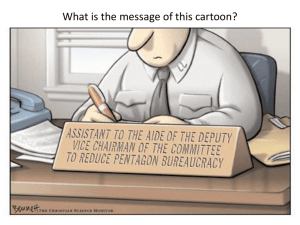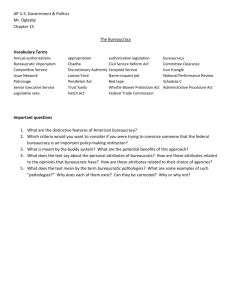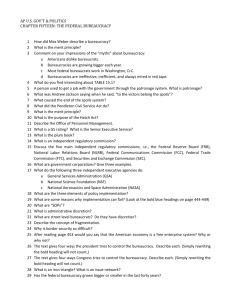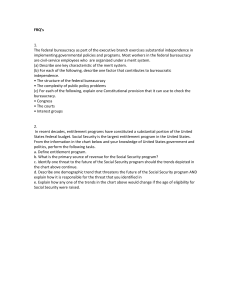Week 1 - Dr. Louis A. Picard Web Site
advertisement
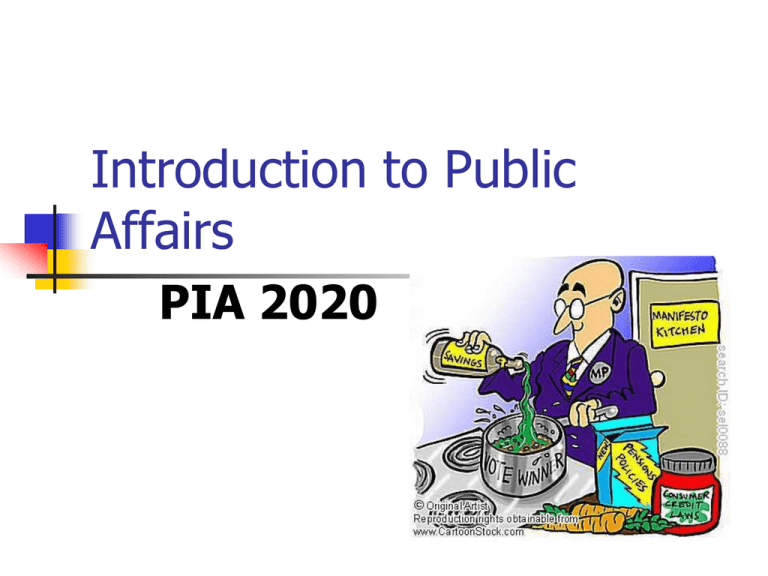
Introduction to Public Affairs PIA 2020 A. Overview of this Session A. B. Course Overview Enduring Features of Governance and Methods A. Central Debate B. Overview of Themes and Historical Legacy Mechanics Picard Website: http://drlouisapicard.wordpress.com/academics/ Reading Assignments: Discussion from Syllabus Course Requirements from the Syllabus (Including PhD students) Questions Course Overview Role of the Teaching Assistant Discussion Sessions Class Introductions Class Members Introduction: Name, degree, background, future plans Assignment: One page biography with picture written in the third person Also need on bio: e-mail address and phone number Course Methodology- 1 Instruction Role of Instructor That of a “Coach” to support efforts to support efforts to pass exams based primarily on readings Two scheduled tests- Mid-term and a Final Exam The Old Coach Michael Phelps (Olympic) Swimmer Your Knowledge of Public Affairs After the Course A. Course Overview: Goals This course focuses on the role of governance and governments both in the contemporary world as well as in its historic context. It is comparative and international in its approach but includes a major discussion of the U.S. case study. (Approx. 1/3 of content). Over the next semester, we will consider a number of broad issues. It is critical for each of you to begin to tie these together in your own mind. Overview: Core Issues 1. General and Enduring Features 2. Contemporary Policy Issues 3. Public Sector Debate 4. Comparative Approach and Culture 5. Influences on the Policy Making Process Influences on the Policy Making Process 1. In terms of operational rules as administrative regulations (objective outputs- Peters) 2. Traditional or habitual actions (subjective impacts on clients) 3. Identify AdministrativeProblems that become policy issues (eg. Corruption) 4. The debate about representation and participation Methodology: General and Enduring Features Goal: Search for General Enduring Features of Governance in Public Affairs Can Allow for comparison of politicians, bureaucracies, structures and systems of Organizations and Institutions (governmental and non-governmental) Methodology: Citizenship Public organizations affect all of us- as potential employees, clients or citizens. The course material is designed to raise as many questions as it answers. Methodology: Themes In order to facilitate this "intellectual disorder" the course will be conducted as a mixture of lecture and structured discussion. Vigorous participation in discussion will be a plus in final grade Methodology: Comparative Methodology and the Readers Digest Approach Compare different areas or systems Compare different times Compare different systems at the same time Compare different processes Bits and Pieces 7. Comparative Methodology? Reviews Methodology: Management Issues Understanding Modern Management It is no longer just the effective administration of people In addition, it is the negotiation and linkages of partnership relations external to organizations The Importance of Time: Advert. Circa.1940 Public Affairs and Public Policy Goals: Macro-Issue a. Avoid the Use of case studies: some form of "theory building" b. Go beyond a narrow culture bound definition of P.A.- The American Case Study (a no-no) c. Focus on administrative systems and esp. the bureaucracy as a common governmental institution in political systems with widely differing decisionmaking patterns Comparative Public Policy and Administration: Public Affairs C. Overview of Themes and Historical Legacy: The Central Debate Mega-Theme: Order vs. Economic Management Historical Parallels The powerful Asian empires especially of China and India. The Ottoman Turks, African, Amerindian Kingdoms Especially in the King's services in Prussia, France, England and other European states. Historical Legacy Modern comparisons are possible across the deepest divisions of system types (Developed vs. Under-development). Between authoritarian and pluralist systems, industrialized and developing systems and secular and religious regimes. Goal and Legacy The great organizations that do the work of modern states and their counterparts in the private and non-profit sector had their counterparts throughout history. Great Organizations? General and Enduring Features, . Patterns of organization, certain common programs of governments, capacities and performance in society Focus: Public Policy and Management and Organizational Dynamics Label: Public Administration The Importance of “Modern Times”- A Theory of Organizations https://www.youtube.com/wat ch?v=ANXGJe6i3G8 Break Time Ten Minute Break Enduring Features of Government and Comparative Methodology Patterns of organization Recruitment of bureaucrats Certain common programs of governments Problem of Dysfuncton Enduring Features in Organizations Capacities and performance The perennial tensions between official (and) Personal norms and the control of bureaucratic power (Corruption) Bureaucracy and Power The control of bureaucratic power, upon which comparisons of diverse bureaucracies can be valid. The Use of History: Historical Kingdoms in Asia, Africa and Europe all precursors to modern state system Recruitment? An Early Bureaucrat Basher Franz KafkaMan About Prague (July 3, 1883June 3, 1924) The Problem: Corruption and Dysfunctional Bureaucracy Kafkaesque 1. 2. 3. Dysfunctional Bureaucracy Maze of Regulations Image of Public Sector as Inefficient Comparative Public Affairs Issues These include ways in which administrators interact with their political environment and influence the policy making process. We will also examine several specific administrative problems that have themselves become contentious policy issues E. Contemporary Policy Issues Democracy and Public Policy- Representation Historical vs. Contemporary Models: Law and Order vs. Economic and Social Policy Governance and Political Economy- Who gets what when and how Recruitment- affirmative action and representative bureaucracy Regulation and Deregulation- Privatization and Contracting Out More Developed States vs. Less Developed States Classification of the countries by developing status. Blue - developed countries Green - developing countries Red - underdeveloped countries ”The Purpose of the Geographic Commands is the "3D" goals (the merging of defense, diplomacy and development)” Referenced from: http://thomaspmbarnett.com/globlogization/tag/usmilitary?currentPage=2#ixzz1WQjbBYKE International Public Policy: The Extractive Industries Transparency Initiative- International Monetary Fund (IMF)- An Example Contemporary Policy Issues-2 Organizations, Socialization and Motivation- Status and Role Theory budgetary decision making- The Fiscus government reorganization- Public Sector Reform Decentralization- Grassroots and Local Governance Civil Society and Social Capital- Pluralism vs. Corporatism International Development and Foreign Aid- and Foreign and Security Policy - The Three D’s (Defense, Diplomacy and Development MCRO-ISSUE F. The Public Sector and Development- Weber vs. Marx One of the major goals of this course will be to examine this issue (Law and Order vs. Social and Economic Change) and Examine the role that the bureaucracy has played in the development process in Europe, the states of the former Soviet Union, the United States and the newly industrializing states of East Asia, Africa and Latin America. International Development Governance in Bangladesh Conflict and Human Security: The Lord’s Resistance Army Public Policy and Management Discussion for Next Week 1. Woodrow Wilson, “The Study of Administration” 2. Franz Kafka, “Bureaucracy” 3. Schiavo-Campo, “Good Governance”
